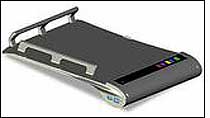Focus, a German magazine covering general news, politics and economics, is very similar to the U.S. newsweeklies Newsweek and Time, according to Anna Maria Deisenberg, the publication’s marketing, communication and research director. In terms of onboard intelligence, however, some issues of Focus had its U.S. counterparts beat during a technology trial last year.
Six households among the publications’ subscribers participated in a test in which RFID technology was used to ascertain which pages of advertisements and editorial content were viewed by a total of 14 individuals in those households. Deisenberg says Focus performed the test because the technology has the potential to provide greater insight into the reading habits and interests of its subscribers. Such information is golden to its editorial department, the company says, as well as to its advertisers.
Focus began working on its reader membership technology four years ago, Deisenberg says, and has spent more than €100,000 ($147,000) on the project. With promising results from the 2007 test, the magazine is currently gearing up to launch another, larger test of the technology that will involve up to 200 readers. But first, the magazine is working with its RFID partners, RF-it Solutions and Magellan Technologies, to remedy some glitches in the system.
During the initial trial, each of the six participating households received their issues in the mail, as usual. But these issues were different than those available to other subscribers or sold on newsstands: The left page of each two-page spread carried a passive 13.56 MHz RFID tag manufactured by Magellan. (A magazine with 50 total pages of ads and editorial, therefore, would have with a total of 25 tags.) The participants were asked to place each RFID-tagged issue into a custom-made magazine holder containing an RFID interrogator before reading it.
The rigid plastic holder was slightly larger than the magazine, in terms of height and width, and roughly 5 millimeters (2 inches) thick. When a tester was ready to read the magazine, that person turned on the RFID interrogator and pressed one of the five buttons built into the holder. Each member of the test household was assigned a specific button and was instructed to read the magazine as he or she normally would.
When the unopened magazine was placed inside the holder, the built-in RFID interrogator was able to detect all tags. Once the magazine’s cover was opened, however, the interrogator detected all tags except for the one on the cover page, because as the cover was lifted up and to the left, the tag was moved out of range. As the next page was opened, the interrogator could see all tags but the ones attached to the cover and first inside page, and so forth, until the participant arrived at the last page of the magazine, and the interrogator had zero RFID tags within its range.
The Magellan RFID tags comply with the ISO 18000-3 air interface standard and have a data transmission rate (also known as a reply data rate) of 106 kilobits per second, enabling the interrogator to read many hundreds of the tags at once. This is why Magellan’s technology is often used in document-tracking applications, where—as with the Focus magazine pages—multiple tags are placed close and atop each other as they are being read.
As the pages were flipped back and forth, and in and out of the interrogator’s range, the device took constant reads. All of this tag data was associated with the person turning the pages, based on which button was pressed before the magazine was opened. The information was then saved to a flash drive inserted into the magazine holder. Once the tests were completed on all tagged issues, the magazine holders and flash cards were returned to the publisher, where RF-it’s software was used to analyze the collected data.
While this data has helped Focus determine how long its testers spent on most pages, Deisenberg says there were times when the tags’ movements in and out of the interrogation zone made it difficult to know which pages the participants were reading, and for how long. “People go through a magazine in a much more chaotic way than we expected,” says Deisenberg. “Sometimes the [interrogator] could not decide which pages were open because of the way the reader was holding the magazine.”
To remedy this situation, Dominik Berger, managing director of RF-it, says his company is experimenting with applying logic to its software that will deduce which page of a specific issue a person is reading during times when particular pages appear to be quickly moving into and out of the interrogation zone.
Before the next test of the technology, Deisenberg says, Focus hopes to refine the design of the holder to make it more comfortable for participants. “One complaint we heard from the first testers is that the holder is clunky,” she states. “It’s not easy to handle the magazine in the way they are used to.”
Even if the magazine begins using the RFID-based system to measure how its issues are read, Deisenberg says, it does not intend to abandon its conventional surveys (in which readers answer questionnaires), because that provides a much more detailed glimpse of its customers’ interests.
Mediamark Research and Intelligence (MRI), a New York-based provider of magazine audience and multimedia research data, is also experimenting with RFID-based readership tracking (see MRI Gearing Up to Test RFID for Tracking Magazine Usage).


